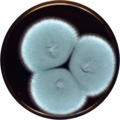Aspergillus marvanovae
| Aspergillus marvanovae | |
|---|---|
| Scientific classification | |
| Domain: | Eukaryota |
| Kingdom: | Fungi |
| Division: | Ascomycota |
| Class: | Eurotiomycetes |
| Order: | Eurotiales |
| Family: | Aspergillaceae |
| Genus: | Aspergillus |
| Species: | A. marvanovae
|
| Binomial name | |
| Aspergillus marvanovae Hubka, S.W. Peterson, Frisvad & M. Kolařík (2013)[1]
| |
| Type strain | |
| CCM 8003[2] | |
Aspergillus marvanovae is a species of fungus in the genus Aspergillus which has been isolated from water with high boracic acid anions from the Dukovany nuclear power station in the Czech Republic.[1][2][3] It is from the Fumigati section.[4] Several fungi from this section produce heat-resistant ascospores, and the isolates from this section are frequently obtained from locations where natural fires have previously occurred.[5] The species was first described in 2014.[4] Aspergillus marvanovae produces apolar indoloterpenes.[6]
Growth and morphology[edit]
A. marvanovae has been cultivated on both Czapek yeast extract agar (CYA) plates and Malt Extract Agar Oxoid® (MEAOX) plates. The growth morphology of the colonies can be seen in the pictures below.
-
Aspergillus marvanovae growing on CYA plate
-
Aspergillus marvanovae growing on MEAOX plate
References[edit]
- ^ a b "Aspergillus marvanovae". Www.mycobank.org.
- ^ a b "Aspergillus marvanovae". Www.uniprot.org.
- ^ Hubka, V.; Peterson, S. W.; Frisvad, J. C.; Yaguchi, T.; Kubatova, A.; Kolarik, M. (12 November 2012). "Aspergillus waksmanii sp. nov. and Aspergillus marvanovae sp. nov., two closely related species in section Fumigati". International Journal of Systematic and Evolutionary Microbiology. 63 (Pt 2): 783–789. doi:10.1099/ijs.0.047076-0. PMID 23148097.
- ^ a b Matsuzawa, T.; Horie, Y.; Abliz, P.; Gonoi, T.; Yaguchi, T. (2013). "Aspergillus huiyaniae sp. nov., a teleomorphic species in sect. Fumigati isolated from desert soil in China". Mycoscience. 55 (3): 213–220. doi:10.1016/j.myc.2013.08.007.
- ^ Samson, R.A.; Hong, S.; Peterson, S.W.; Frisvad, J.C.; Varga, J. (2007). "Polyphasic taxonomy of Aspergillus section Fumigati and its teleomorph Neosartorya". Studies in Mycology. 59: 147–203. doi:10.3114/sim.2007.59.14. PMC 2275200. PMID 18490953.
- ^ Frederic, Lamoth; William J., Steinbach (2016). Advances in Aspergillus fumigatus pathobiology. Frontiers Media SA. ISBN 978-2-889-19789-7.


